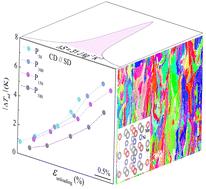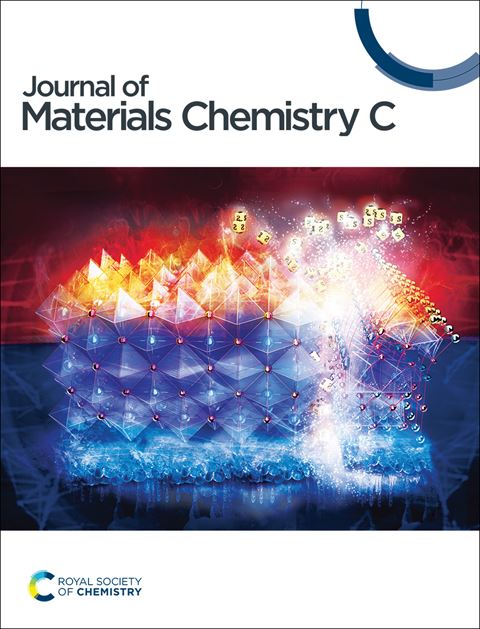具有大弹性效应的镍-锰-锰合金一步快速成型技术
IF 5.7
2区 材料科学
Q2 MATERIALS SCIENCE, MULTIDISCIPLINARY
引用次数: 0
摘要
镍-锰-锰元磁形状记忆合金具有高度可调的磁性能和巨大的弹性效应,因此在固态制冷领域备受关注。然而,它们固有的脆性阻碍了其实际应用。激光粉末床熔融(L-PBF)快速成型技术可以克服脆性合金的加工困难,实现自由形状的几何设计。同时,快速冷却的熔池也有利于获得奥氏体功能相。然而,L-PBF 合金的弹性热效应,尤其是未经热处理直接印制的块状材料的弹性热效应,在镍锰基合金中尚未得到系统研究。本研究采用一步法 L-PBF 方法,成功地在 Ni45Mn44Sn11 合金中获得了奥氏体相的快速凝固微观结构,而无需热处理。L-PBF 样品的相对密度最大达到 98.20%,熵变值稳定在 26 至 31 J kg-1 K-1 之间。与沿建筑方向压缩相比,由于柱状晶粒和微米级缺陷占主导地位,沿扫描方向压缩时实现了令人印象深刻的更大弹性热量温度变化(6.7 K)。在 5 T 的外磁变化下,实现了 4.8 J kg-1 K-1 的最大熵变。这项研究为快速构建具有较大弹性热效应的固态制冷合金提供了一种简化方法。本文章由计算机程序翻译,如有差异,请以英文原文为准。

One-step additive manufacturing of Ni–Mn–Sn alloys with a large elastocaloric effect
Ni–Mn–Sn metamagnetic shape memory alloys have garnered significant attention in solid-state refrigeration due to their highly tunable magnetic properties and large elastocaloric effects. However, their intrinsic brittleness hinders practical application. Laser powder bed fusion (L-PBF) additive manufacturing technology can overcome the machining difficulties of brittle alloys, enabling freeform geometrical design. Meanwhile, the rapidly cooled melt pool also facilitates the attainment of austenite functional phases. However, the elastocaloric effect of L-PBF alloys, especially for directly printed bulk materials without heat treatment, has not been systematically studied in Ni–Mn-based alloys. This work successfully obtained a rapidly solidified microstructure with austenite phases in Ni45Mn44Sn11 alloys using a one-step L-PBF method without heat treatment. The relative densities of the L-PBF samples reached a maximum of 98.20%, with the entropy change values remaining stable in the range of 26 to 31 J kg−1 K−1. Compared to compression along the building direction, impressive and larger elastocaloric temperature changes (6.7 K) were achieved when compressing along the scanning direction due to the dominance of columnar grains and micron-sized defects. A maximum entropy change of 4.8 J kg−1 K−1 is achieved under an external magnetic change of 5 T. This work offers a simplified method for rapidly constructing solid-state refrigeration alloys with a large elastocaloric effect.
求助全文
通过发布文献求助,成功后即可免费获取论文全文。
去求助
来源期刊

Journal of Materials Chemistry C
MATERIALS SCIENCE, MULTIDISCIPLINARY-PHYSICS, APPLIED
CiteScore
10.80
自引率
6.20%
发文量
1468
期刊介绍:
The Journal of Materials Chemistry is divided into three distinct sections, A, B, and C, each catering to specific applications of the materials under study:
Journal of Materials Chemistry A focuses primarily on materials intended for applications in energy and sustainability.
Journal of Materials Chemistry B specializes in materials designed for applications in biology and medicine.
Journal of Materials Chemistry C is dedicated to materials suitable for applications in optical, magnetic, and electronic devices.
Example topic areas within the scope of Journal of Materials Chemistry C are listed below. This list is neither exhaustive nor exclusive.
Bioelectronics
Conductors
Detectors
Dielectrics
Displays
Ferroelectrics
Lasers
LEDs
Lighting
Liquid crystals
Memory
Metamaterials
Multiferroics
Photonics
Photovoltaics
Semiconductors
Sensors
Single molecule conductors
Spintronics
Superconductors
Thermoelectrics
Topological insulators
Transistors
 求助内容:
求助内容: 应助结果提醒方式:
应助结果提醒方式:


